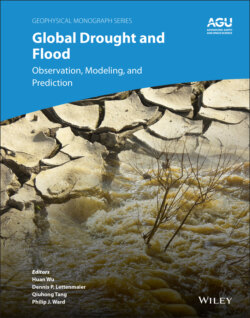Читать книгу Global Drought and Flood - Группа авторов - Страница 35
2.3.4. Evaporative Stress Index
ОглавлениеSpatial and temporal variations in instantaneous ET at the continental scale are primarily due to variability in moisture availability (antecedent precipitation), radiative forcing (cloud cover, sun angle), vegetation amount, and local atmospheric conditions such as air temperature, wind speed and vapor pressure deficit. Potential ET describes the evaporation rate expected when soil moisture is nonlimiting, ideally capturing response to all other forcing variables. To isolate effects due to spatially varying soil moisture availability, a simple ESI can be developed from model flux estimates, given by 1 minus the ET/PET ratio following the formulation of the CWSI (Crop Water Stress Index; Idso et al., 1981) and WDI (Water Deficit Index; Moran et al. 1994). Using the ALEXI model, we can derive evaporative stress indices associated with the canopy (ESI c), the soil surface (ESI s), and the combined plant–soil system (ESI):
(2.24)
(2.25)
(2.26)
where E C, E S, and E are the modeled actual ET fluxes (mm) from the canopy, soil and system, respectively, and PET C , PET S , PET are potential rates associated with these components (mm). These indices have a value of 0 when there is ample moisture/no stress, and a value of 1 when evapotranspiration has been cut off because of stress‐induced stomatal closure and/or complete drying of the soil surface (Anderson et al., 2007).
